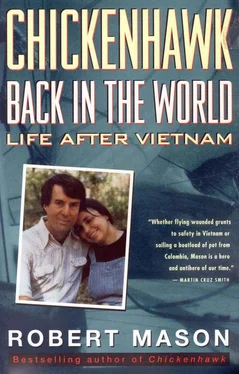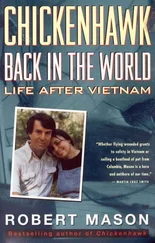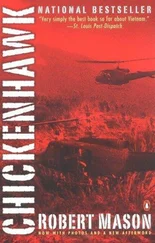Robert Mason - Chickenhawk - Back in the World - Life After Vietnam
Здесь есть возможность читать онлайн «Robert Mason - Chickenhawk - Back in the World - Life After Vietnam» весь текст электронной книги совершенно бесплатно (целиком полную версию без сокращений). В некоторых случаях можно слушать аудио, скачать через торрент в формате fb2 и присутствует краткое содержание. Год выпуска: 2013, Издательство: BookBaby, Жанр: Старинная литература, на английском языке. Описание произведения, (предисловие) а так же отзывы посетителей доступны на портале библиотеки ЛибКат.
- Название:Chickenhawk: Back in the World - Life After Vietnam
- Автор:
- Издательство:BookBaby
- Жанр:
- Год:2013
- ISBN:нет данных
- Рейтинг книги:3 / 5. Голосов: 1
-
Избранное:Добавить в избранное
- Отзывы:
-
Ваша оценка:
- 60
- 1
- 2
- 3
- 4
- 5
Chickenhawk: Back in the World - Life After Vietnam: краткое содержание, описание и аннотация
Предлагаем к чтению аннотацию, описание, краткое содержание или предисловие (зависит от того, что написал сам автор книги «Chickenhawk: Back in the World - Life After Vietnam»). Если вы не нашли необходимую информацию о книге — напишите в комментариях, мы постараемся отыскать её.
Chickenhawk: Back in the World - Life After Vietnam — читать онлайн бесплатно полную книгу (весь текст) целиком
Ниже представлен текст книги, разбитый по страницам. Система сохранения места последней прочитанной страницы, позволяет с удобством читать онлайн бесплатно книгу «Chickenhawk: Back in the World - Life After Vietnam», без необходимости каждый раз заново искать на чём Вы остановились. Поставьте закладку, и сможете в любой момент перейти на страницу, на которой закончили чтение.
Интервал:
Закладка:
John said we should all get on the mainsail winch. More force was the answer. The three of us hung on the handle, jerking down with all our might. We even made the thick bronze handle bend, but the Namaste did not budge.
I got a piece of paper, drew my plan, and showed it to John. I spoke quietly, trying not to sound superior about it. “See, John. Most of the weight of the boat is in the keel, and the way you’ve got it now, we’re trying to raise the keel out of the water. If the keel was touching the bottom, it would work. I know, you don’t want to be on the bottom because we might not get her off. Fine. So we have to make her think she’s on the bottom. That’s what will happen if we run the line under the keel.”
John nodded reluctantly. “That’ll do it, you think?”
“Yes, if we re-rig the masthead pulley, too. It’s got way too much friction with the line going the wrong way.”
“We’ll try moving the anchor line,” John said. “We’ll see what happens.”
“But—”
“We’ll re-rig the anchor line. Bob,” John announced.
Bob and I let out the mainsail line and the Namaste was once again standing bolt upright. It was getting close to ten o’clock. I undid the anchor line and Bob swam it under the keel and up on the other side. I pulled it through a guide and into a deck winch and took up the slack.
We winched the top over again. The Namaste leaned farther over than before, but as the line left the mast at ever increasing angles, the friction at the masthead increased.
“I didn’t think it would work,” John said, going below for a beer.
I followed him down. “John,” I said as he reached into the cooler. “I know this’ll work.” I tapped my drawing. “We know your way won’t. We can winch on that fucking thing until the line breaks—it’s cinched up tight as a knot. It’s not going to work and you know it.”
“You know my way won’t work?” John glared at me. “I’m the fucking sailor here, Bob. I’ve done this before.”
“It doesn’t matter, John. It’s simple physics.”
John shook his head angrily. “Physics? Shit. I fucking hate it when goddamn academics try to take on the real world.”
“I’m not an academic, John. I’m good at this stuff.”
“Not an academic? Not an academic? You’re a fucking writer.”
“Really? Seen any of my books? I was a farm kid, John. Had to invent all kinds of gadgets to get out of doing chores. Then the Army: helicopters—ever seen anything more complicated than a helicopter? Then the mirror business—invented all kinds of machines there. I see what we have to do. That’s all.”
“That’s not all,” John said, swigging from his beer. He swallowed and said, “You know what your problem is, Mason?”
“No, John. What is my problem?”
“You want to be the fucking captain.”
I didn’t want to be the captain. As it was, I was the worst crewman you could imagine: an argumentative know-it-all sailor on his first trip in a sailboat.
We went on deck and ate some peanut butter sandwiches for lunch. John stared at the island while I explained to Ireland, for John’s benefit, my plan. Ireland nodded, but refused to take sides. I asked him if he thought it would work. “Don’t know, Ali. I’m just a dinger,” he said, looking worried.
After lunch John said, “We could just haul a pulley block up to the masthead with the mainsail halyard. Then we could run the beach line through that pulley and down to one of the winches. That should work.”
“That’ll work great,” I said.
Once the decision was made, things brightened up. Ireland and I rowed back to the beach and untied the line so John could pull in enough slack to make the changes. John put the beach line through a big pulley block he’d found in our spare-parts drawer and hooked the block to the mainsail halyard. By the time we got back, he’d run the beach line through the pulley and wrapped the end around a winch. He was raising the pulley, with the beach line through it, up to the masthead as we climbed aboard.
Ireland and I cranked the beach line through a winch in the cockpit and John winched the anchor line tight next to us. The mast went over, the keel flipped up. The Namaste leaned over until the port gunwale went underwater. We got the side of the keel to the surface, probably could’ve laid the boat flat with the leverage we had.
We spent another hour drilling a two-inch hole in the bottom of the hull. John and Ireland worked outside, sitting in the dingy. Ireland held the dingy against the hull with a line tied to the safety rail while John drilled a hole where he wanted the transducer for the depth finder. When the pilot hole came through, I drilled from inside with a two-inch hole-saw set in a brace. Took about twenty minutes to grind through the hull, which was two inches thick on the bottom. The plug fell out and I could see John and Ireland smiling outside. We set the depth finder’s transducer in the hole in a bed of epoxy.
The Namaste lay cocked on its side for four hours while the epoxy set. We played with the dingy and skin-dived.
Late in the afternoon, we let the Namaste back upright. I ran a wire from the transducer to the depth-finder dial we’d installed next to the compass in the cockpit. We flipped on the power and, sure enough, the thing said two feet. Watching the finder tell us the water was getting deeper as we pulled ourselves out to the anchor was fun.
We anchored out far from shore, out of range of the sand flies, and broiled three big steaks. We toasted our success with beer, told jokes, and yelled insults at the sand flies. It felt like we’d really done something.
The next morning we sailed back to Saint Thomas Basin to finish provisioning the boat. And to meet the scam master.
John brought him out to the Namaste in the dingy the day after we got back to the harbor. His name was Dave, and he’d brought his wife, Nancy, with him. They looked just like any other couple on a weekend jaunt. They climbed aboard, to a thoroughly spiffed-up Namaste. Ireland and I had been cleaning up the boat all morning. John introduced us and I found out that Dave was a Vietnam vet, too. He’d been a grunt in 1969, earned a Purple Heart. That made me feel a little better. Most grunts I knew were good at keeping cool under pressure. I’d learned, from John, that Dave had made this his mission by pushing out the usual scam master. Dave had put this whole deal together and had a point to prove to the boss—that he was as good as the other scam master. Dave was clawing his way up the corporate ladder.
We talked for a while in the cockpit. Dave was impressed that I’d been a helicopter pilot; loved helicopter pilots because they’d saved his ass a bunch of times.
Nancy pulled from her purse a brown-paper package the size of a thick novel and handed it to John. John tore it open like it was Christmas morning. Inside were twenty-five rubber-banded bundles of money. Twenty-five thousand dollars. They excused Ireland and me while they talked business. Dave had all the codes and times for the pickup and wanted to brief John. Ireland and I went forward, sat against the cabin bulkhead on the foredeck, and smoked pot. “That money isn’t for the pot, is it?” I said.
“I don’t think so,” Ireland said. “We’re picking up probably a hundred and fifty thousand worth. That’s probably just the buyer’s fee.”
A half hour later, John called us back and said Dave was taking us all out to dinner.
The next morning, John announced this would be our last day in Saint Thomas. We could use the time to tie up loose ends, make our last phone calls. We went ashore. I helped John shop for a box of silicon sealant he wanted to caulk the gunwales with. We’d detected some leakage: the lockers under the bunks were sloshing with water.
Читать дальшеИнтервал:
Закладка:
Похожие книги на «Chickenhawk: Back in the World - Life After Vietnam»
Представляем Вашему вниманию похожие книги на «Chickenhawk: Back in the World - Life After Vietnam» списком для выбора. Мы отобрали схожую по названию и смыслу литературу в надежде предоставить читателям больше вариантов отыскать новые, интересные, ещё непрочитанные произведения.
Обсуждение, отзывы о книге «Chickenhawk: Back in the World - Life After Vietnam» и просто собственные мнения читателей. Оставьте ваши комментарии, напишите, что Вы думаете о произведении, его смысле или главных героях. Укажите что конкретно понравилось, а что нет, и почему Вы так считаете.












